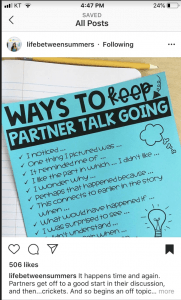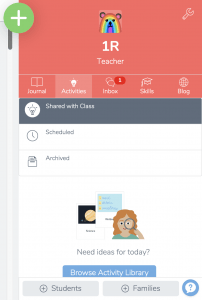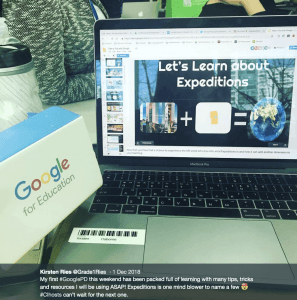I’m excited by the idea of further technological advancements mentioned at Learning Predictions 2017- The Future of Learning. The prediction of anticipatory technology using the data of our activities online (soci al media) to anticipate what we want to learn.
al media) to anticipate what we want to learn.
I believe I already see it in action when using my teacher social media platforms such as Instagram. The hashtag I use most, #firstgrade, always makes its way into my feed and shows me popular posts by other teachers that I then bookmark and save to my profile as ideas to try later. One example is on the right >
Augmented reality and coding apps, Virtual Reality e.g. Google Expeditions, are the latest thing in educational technology resources and these tools, that are exciting to some educators, it’s true that it can be overwhelming to others. In my current reading for the Book Review, Future Wise: Educating Children for a Changing World, Perkins borrowed the quote “inconvenient truth” from Al Gore. It fits the situation of the gap for educators effectiveness and knowledge on integrating technology into their classrooms. It’s true for me but I am slowly lessening the gap! Below is my tweet about learning to use Google Expeditions at the Google Apps Events PD in Incheon last year.
 The next step I’d like to take in my classroom practice is to introduce my students to the world of blogging through the platform Seesaw (pictured to the left). The blogging aspect will be a new tool for me and my students, but I agree with Starkey (2011) that sharing created knowledge could be seen as the penultimate learning experience (p. 25).
The next step I’d like to take in my classroom practice is to introduce my students to the world of blogging through the platform Seesaw (pictured to the left). The blogging aspect will be a new tool for me and my students, but I agree with Starkey (2011) that sharing created knowledge could be seen as the penultimate learning experience (p. 25).
Having information so readily available and easy to access as a teacher and lifelong learner is like an inside scoop that did not exist for teachers and learners less than a generation ago. This brings me to information theory. I actually related a lot of what I read from Module 2 back to our webinar with Jane Humphreys, such as the C.R.A.P test. Learner’s as young as Grade 1 and Kindergarten are accessing information on the internet and unless explicitly taught to analyze the information they will take everything they read as reputable knowledge. This is a highly important lesson, especially in the age of user-generated content.
Revised Bloom’s Taxonomy Activity
| The Cognitive Process Dimension V
The Knowledge Dimension > |
Factual
Know some basic elements in order to solve |
Conceptual
Interrelationships among basic elements and how they function |
Procedural
How to do something, methods of inquiry, skills techniques methods. |
Metacognitive
knowledge of and the ability to monitor and develop one’s own powers of thought. |
| Remember | List the alphabet | List parts of animals | Access the Seesaw App | Identify reading strategies you need help with. |
| Understand | Know that the alphabet has letter names and letter sounds to form words | Understand why animals have different parts for different reasons e.g. survival. | Know where to go to take a photo, video or do a drawing on Seesaw | Clarify your understanding about certain skills and processes. |
| Apply | Read CVC words based on letter-sound knowledge | Connect parts of animals to different technology humans have developed. | Take a photo, video or do a drawing
*feels similar to create |
Use skills or technology that you know are to your strengths. |
| Analyze | Sort words into word families | Investigate why humans took this inspiration from animals to solve certain problems e.g. termites nest= AC in buildings, turtles shell= helmet. | Decide whether this photo, video, drawing, recording is of good enough quality (WOW work) to upload | Look at why something is not working the way you want it to. |
| Evaluate | Discuss why these words were sorted this way | Find a problem you could solve with animal inspiration. | Add comments to other classmates work | Reflection of progress, redesign to solve problems |
| Create | Create sentences using these words | Create your own design for a human problem that could be solved with inspiration from an animal. | Add more details or use more than 1 mode of creation in the app
*feels similar to Apply |
Create a reflection journal. |
I wanted to apply real-life happenings to Blooms revised taxonomy to deepen my understanding of how my students are learning and at what levels at certain times. I found it tricky at some points and I’m not sure how accurate I am for some of the taxonomies in relation to the knowledge dimension. I did make a note that my example for Apply felt very similar to Create under the Procedural dimension.
When thinking in networks I agree that innovative pedagogies and ways of thinking should come first before the technology use (more on that in my final paragraph). I feel that I have been taught to be more of a knowledge consumer but, so far, in this course, I am reaching for more critical use of the information I gather on a daily basis from knowledge networks and Web 2.0 platforms.
Interestingly I found some contrast between George Siemens conclusion in his interview discussing Connectivism and Mimi Ito Why connected learning?
George: “Your income and your socioeconomic place is a direct determiner of your academic success in this digital age”
Mimi: “There’s nothing from a resourcing point of view that is an issue in the ever widening socioeconomic gap in society. Technology is actually more easily accessible”
Having taught in opposite ends of the socio-economic spectrum I can easily say that my opinion aligns more with Siemens. I have first hand been an individual teacher at a loss with how to use technology in my classroom due to lack of resources. Compare that with now where I feel confident enough to lead professional development opportunities for my colleagues to integrate technology into their own classrooms from my own experiences. This comes from having better access to resources such as 1:1 devices for my students.
Finally, I stick firmly to the quote “pedagogy before technology”. This is something I first heard at a recent Google Apps Event in Incheon, South Korea from Craig Kemp. This quote floated back into my head during Modules 2 & 3. Read his blog post titled Pedagogy first, technology second! here. As concluded by Philip & Garcia (2013) technology absent of pedagogy will detract from instead of contributing to learning. It is an important foundation for educators to begin their journey to authentic technology teaching and integration.
I’m going to finish with a couple of practice reference that I would love one of my blogging buddies to check over for me! This is my first time using APA referencing and I’d love a bit of practice before the Book Review is due. Thank you in advance! I will return the favour.
References
(2011). Evaluating learning in the 21st century: A digital age learning matrix, Technology, Pedagogy and Education, 20:1, 19-39. doi: 10.1080/1475939X.2011.554021
Perkins, D. (2014). Future wise: Educating our children for a changing world. John Wiley & Sons.


Thanks for sharing your experiences on so many aspects of ed-tech and their uses.
As someone who is solely immersed in the world of adult education, I was surprised to see how much the reflections you shared on first-grade teaching resonated with me. Like yourself, I’ve always tried to follow the ‘pedagogy before technology’ model of teaching (not always easy with the bright shiny lights of the tech world). However, I can see the importance of this principle throughout the teaching world. For another course I undertook, I created a video on the work of George Siemens which highlights some of the ways my role has changed with ed-tech (https://www.youtube.com/watch?v=GOx3erzlghE).
What really struck me was the teaching of analytical thinking from first-grade as this is something many of my adult students still struggle to comprehend. The importance of this competency can’t be underestimated in my opinion especially as we progress social media platforms and the inherent learning (both good and bad) within them.
As a non-digital native, like yourself, I’ve had to learn technologies and apply them to the educational environment. Part of my learning journey was attending a PD session on Virtual Reality. Within this, we were provided with the history of Virtual Reality. I’ve provided a link to the societies web page here and some of the devices are fascinating. https://www.vrs.org.uk/virtual-reality/history.html
Your comment on teaching on the opposite ends of the socio-economic spectrum also resonated. Many of my students are from low SES backgrounds as well and technology can widen rather than close the gap, a point made in the book I recently reviewed ‘Is Technology Good for Education?’ by Neil Selwyn (https://www.amazon.com/Technology-Good-Education-Digital-Futures/dp/0745696473). The book looks at technology from some unusual aspects including educational equity, social justice and democratisation of education.
Kirsten thanks again for the post I really enjoyed reading it and the thoughts it stimulated within my own learning.
Kirsten,
I enjoyed reading your post as an educator i the field. I have been out of the classroom in a resource position for over two years. I support technology integration through my role as Technology Enabled Learning Teacher Contact. What you shared at the end of your post regarding pedagogy before technology was very powerful to me. My book study Invent to Learn by Martinez and Strager, 2019, was all about making and learning by doing. Much of what was shared in the book was about how educators need to try new technologies and let learning get messy as innovation continues. Examples of this include 3D printing, robotics, coding and sharing learning through online platforms. Where is the balance between pedagogy and learning along side students. Where do you see the overlap if there is any?
Thanks for sharing your experiences on so many aspects of ed-tech and their uses.
As someone who is solely immersed in the world of adult education, I was surprised to see how much the reflections you shared on first-grade teaching resonated with me. Like yourself, I’ve always tried to follow the ‘pedagogy before technology’ model of teaching (not always easy with the bright shiny lights of the tech world). However, I can see the importance of this principle throughout the teaching world. For another course I undertook, I created a video on the work of George Siemens which highlights some of the ways my role has changed with ed-tech click here to watch.
What really struck me was the teaching of analytical thinking from first-grade as this is something many of my adult students still struggle to comprehend. The importance of this competency can’t be underestimated in my opinion especially as we progress social media platforms and the inherent learning (both good and bad) within them.
As a non-digital native, like yourself, I’ve had to learn technologies and apply them to the educational environment. Part of my learning journey was attending a PD session on Virtual Reality. Within this, we were provided with the history of Virtual Reality. I’ve provided a link to the societies web page here and some of the devices are fascinating. https://www.vrs.org.uk/virtual-reality/history.html
Your comment on teaching on the opposite ends of the socio-economic spectrum also resonated. Many of my students are from low SES backgrounds as well and technology can widen rather than close the gap, a point made in the book I recently reviewed ‘Is Technology Good for Education?’ by Neil Selwyn. The book looks at technology from some unusual aspects including educational equity, social justice and democratisation of education.
Kirsten thanks again for the post I really enjoyed reading it and the thoughts it stimulated within my own learning.
Cheers,
Paul
Kirsten, a personalised post that covers quite a bit of ground in terms of educational technology. I applaud your sharing of research and personal opinion. Your post is well crafted with hyperlinks and embedded media. APA 6th – watch out for book citations, there should be a location not just a publisher.